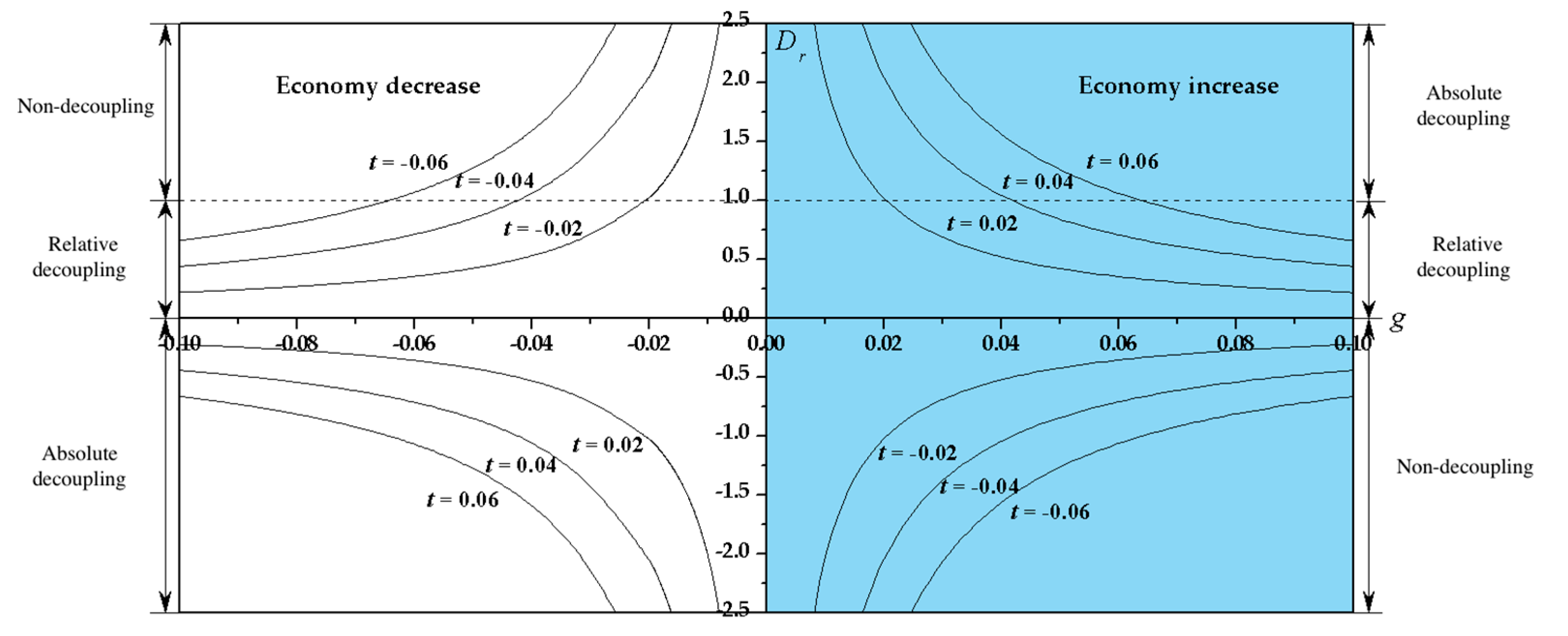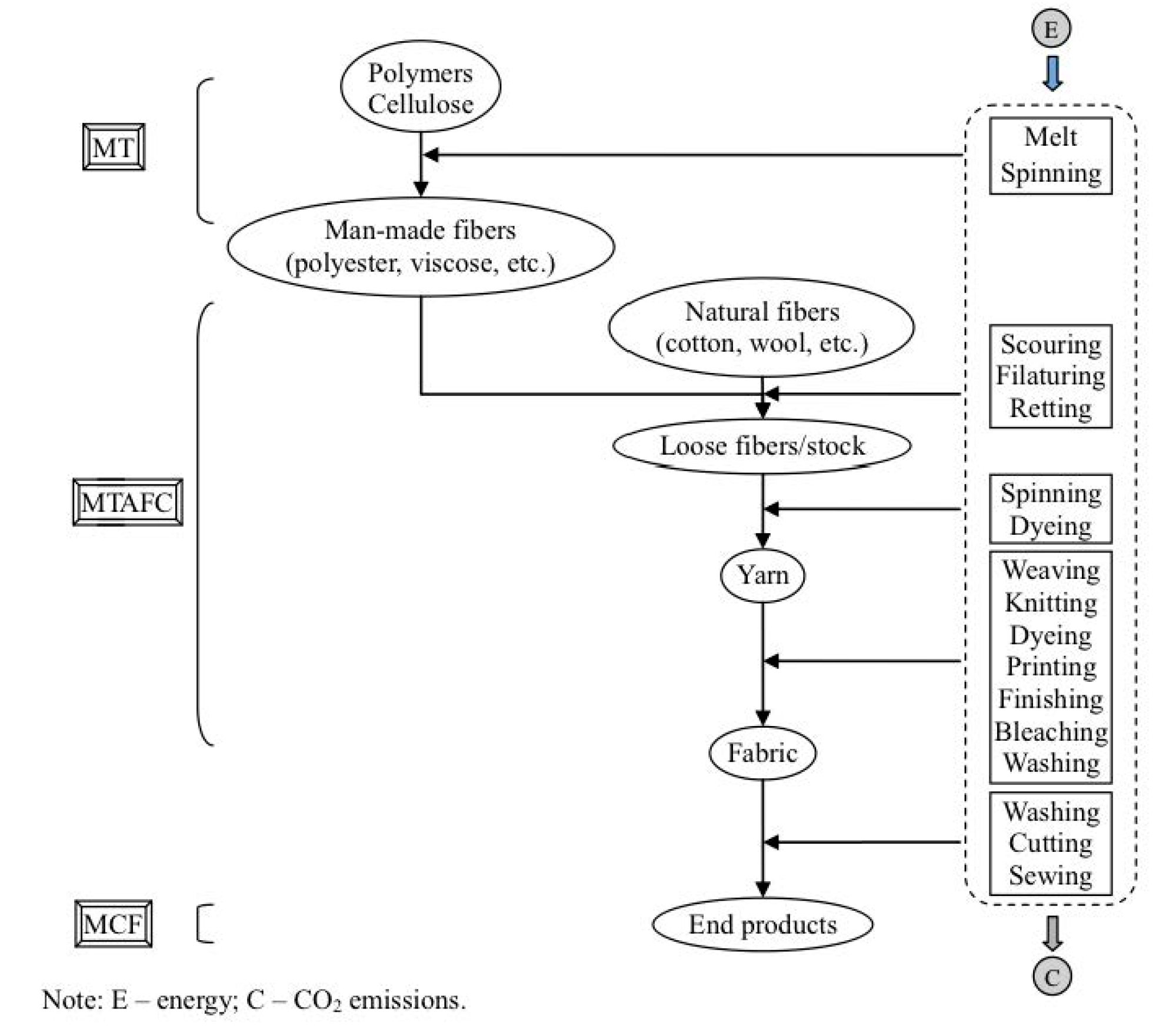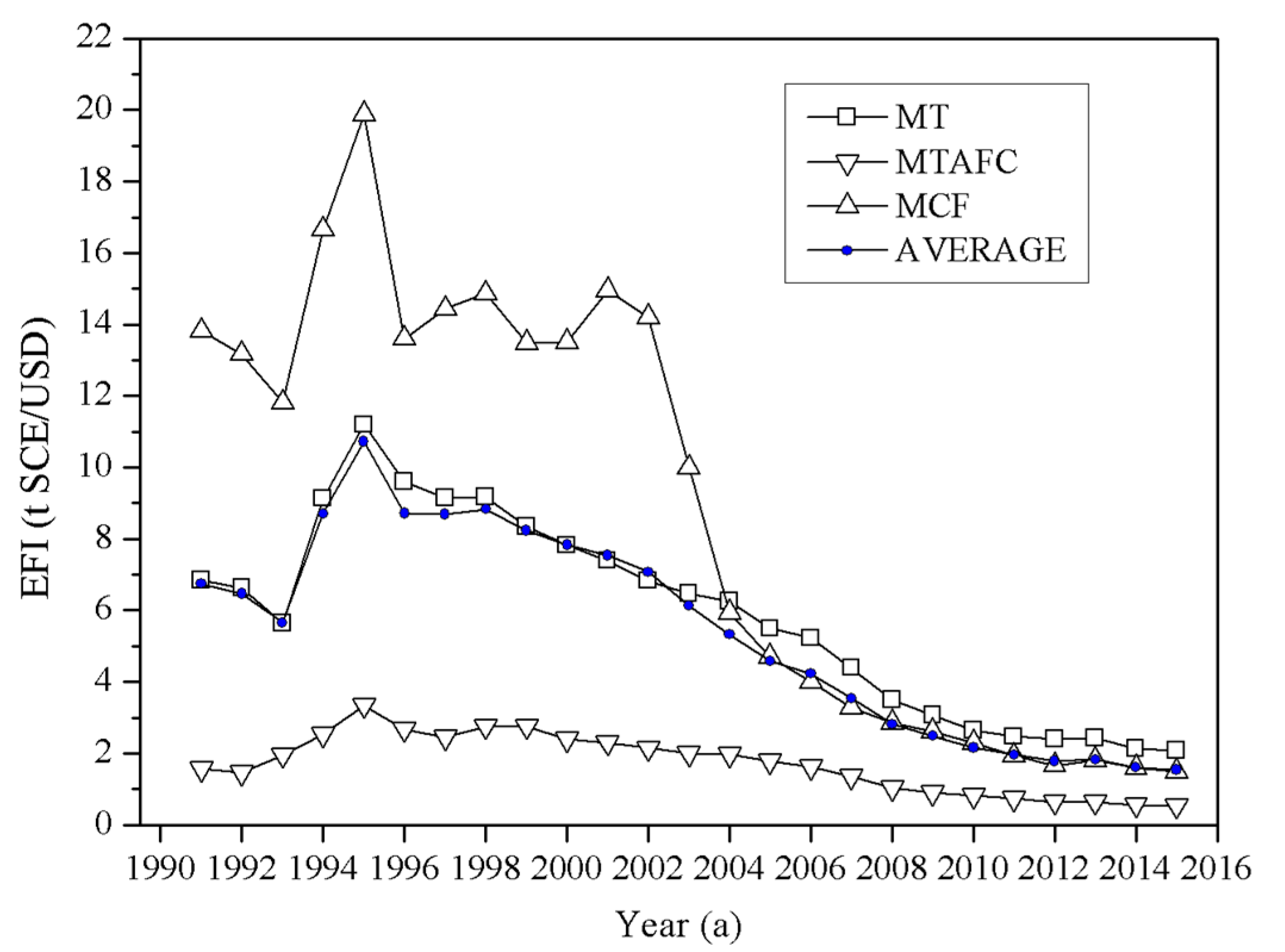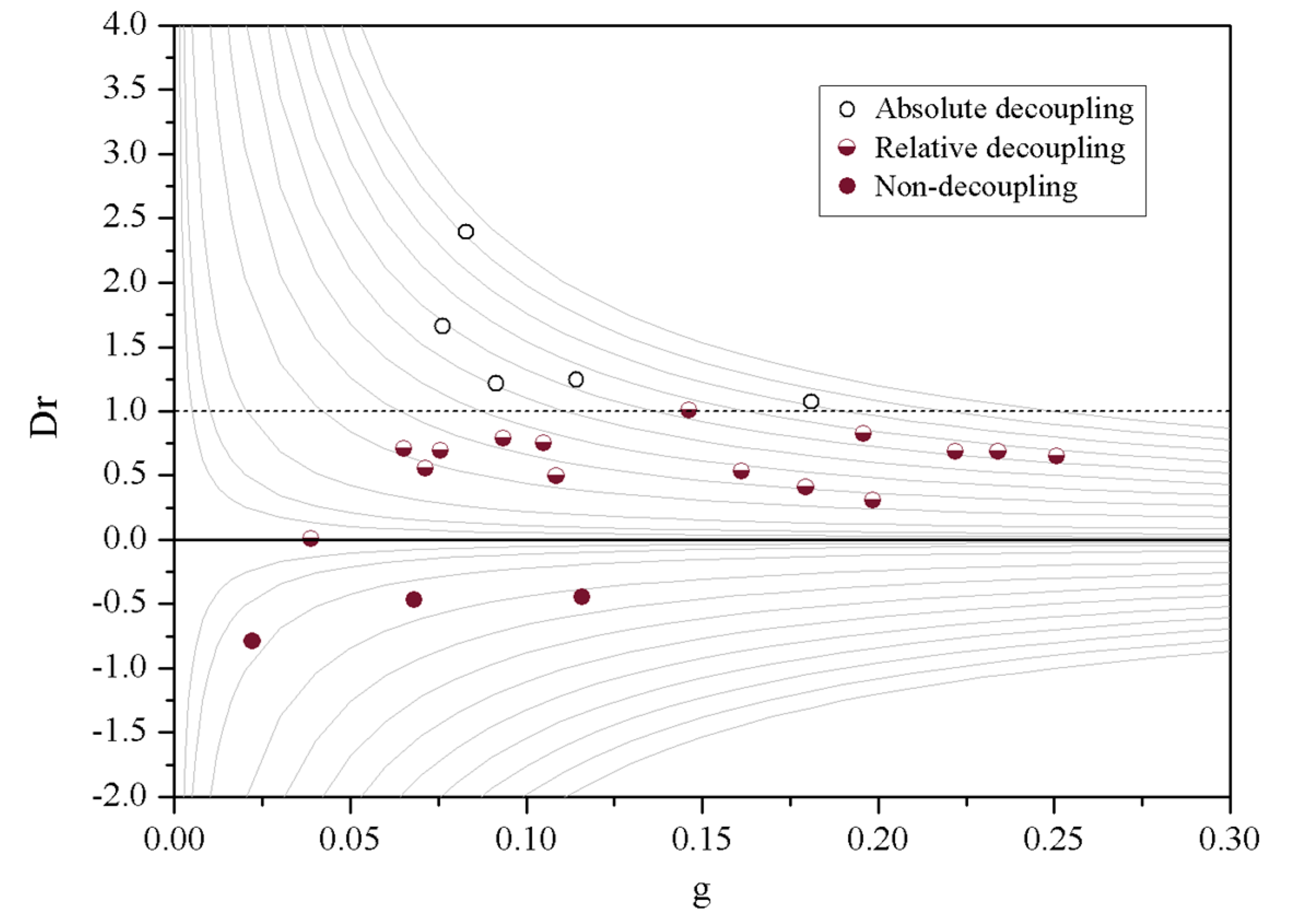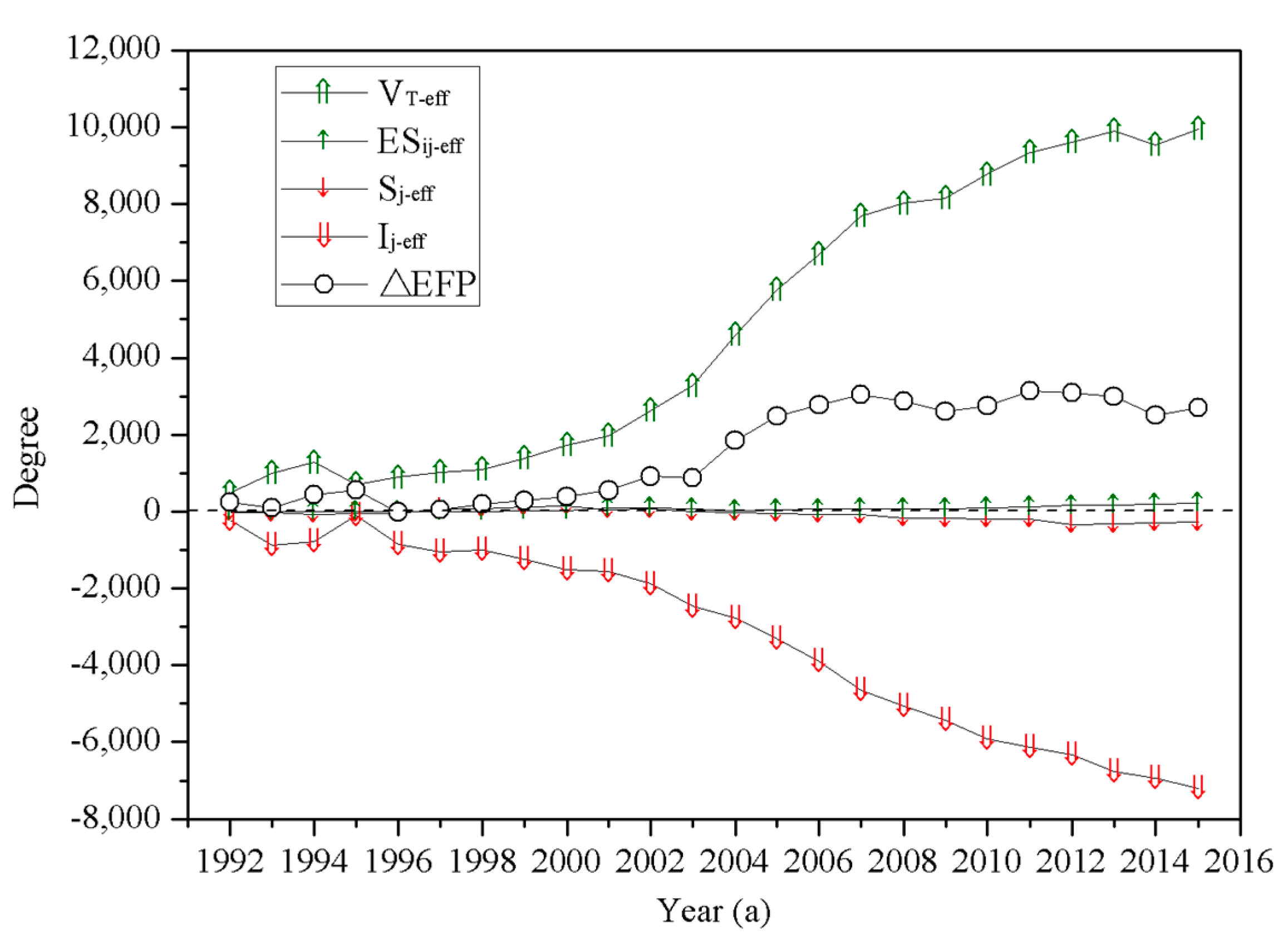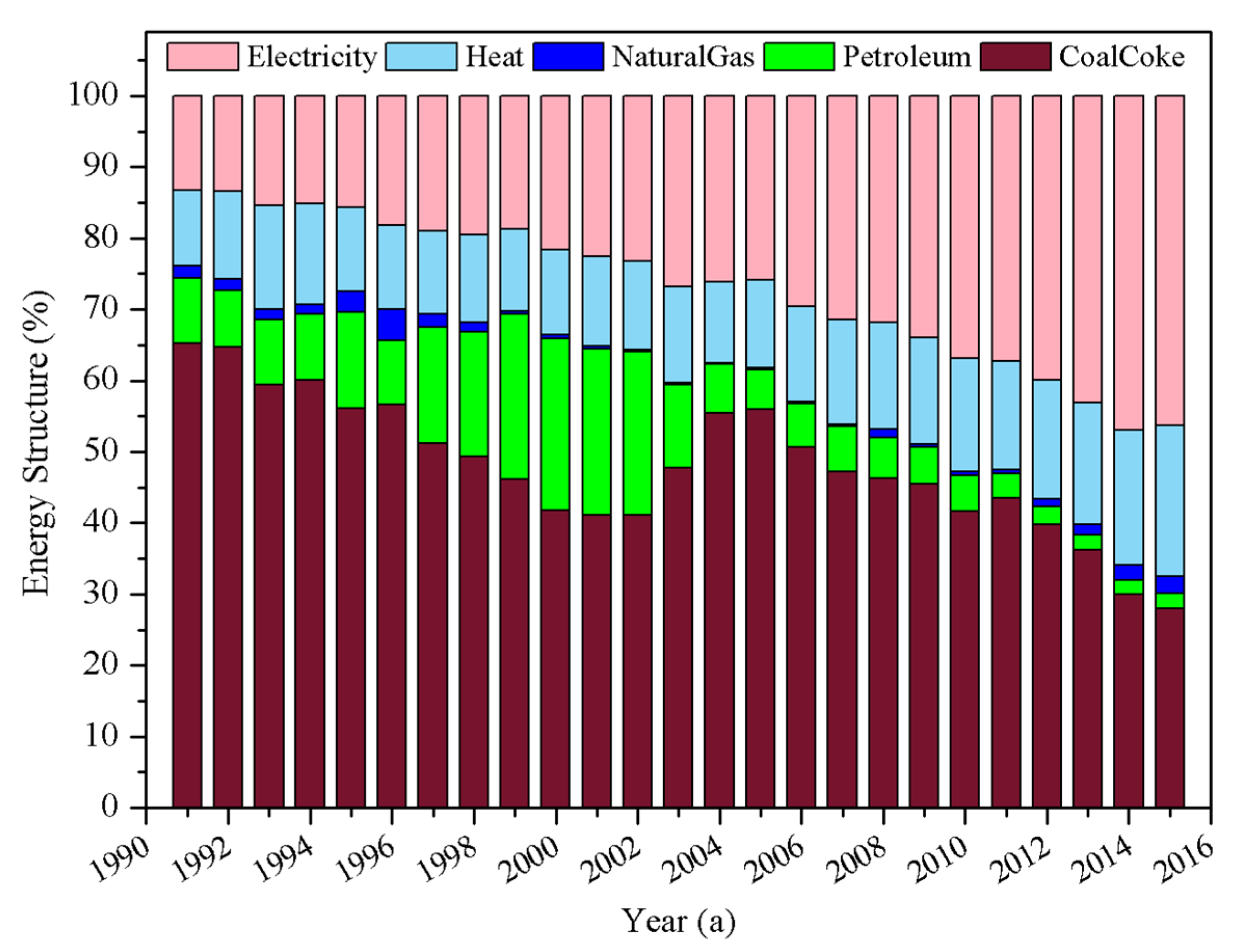1. Introduction
Energy-related greenhouse gas (GHG) emissions have raised a great deal of concern in recent decades, as GHGs have an adverse environmental impact [
1]. The world’s consumption of energy increased from 4661 Mt in 1973 to 9425 Mt in 2014 according to statistics of the International Energy Agency [
2]. The statistics also showed that the industry sector occupied approximately 30.5% of the world’s total energy (i.e., coal, oil, natural gas, electricity) consumption in 2014. The concentration of energy saving technologies and energy efficiency assessment methods in industry sectors has increased significantly in order to reduce GHGs emissions.
The textile industry is a significant contributor to many national economies, encompassing both small and large-scale operations worldwide [
3]. The global fiber production has increased rapidly with the growing consumption of textiles and clothing. It is reported that global fiber production was approximately 97.8 million tons in 2016 [
4]. Energy is the essential input for every operation along the industrial manufacturing chain of textiles. In general, the textile industry is not considered an energy-intensive industry compared with the metal smelting industry or the raw chemical materials and chemical products manufacturing industry. However, the textile industry comprises a large number of plants, which together consume a significant amount of energy.
China has been the world’s largest producer and exporter of textiles and clothing since 1994 according to WTO trade statistics [
5]. The fiber production of China’s textile industry occupies more than 50 percent of the global fiber production [
6]. The textile industry is a recognized traditional pillar industry in China. Specifically, China’s textile industry contributes to increasing employment and income, promoting urbanization and social development. However, it also consumed large quantities of energy in the past thirty years of rapid development. China’s textile industry is facing great pressure to reduce industrial energy consumption. During the 13th Five-Year-Plan period (i.e., from 2016 to 2020), the energy consumption per unit industrial value-added of China’s textile industry must decrease by more than 18 percent [
6].
Globally, the textile industry has become one of the industries concerned with sustainable initiatives. Several studies have paid attention to energy consumption in the textile industry. Rasul [
7] and Kruska et al. [
8] elucidated the rational use of energy in textile industry. In addition, Rasul presented in detail a number of feasible options for energy conservation measures in the textile industry. Kruska et al. introduced innovative technologies of energy use in textile industry. Abdel-Dayem et al. [
9] and Muneer et al. [
10] investigated the potential of solar energy utilization in the textile industry. Palanichamy et al. [
11] shared the experiences of economic and efficient measures of energy conservation in the textile industry situated in Tamilnadu State, India. They also studied energy use in the Indian textile industry and presented the energy-efficiency potential availability, as well as suggesting some energy policies suitable for the Indian context to achieve the estimated energy-savings potential [
12]. Tang et al. [
13] established models for the ratio of energy consumption to yarn production over a full yarn package based on an analysis of power distribution during yarn winding in ring spinning. Ozturk [
14] estimated the energy consumption and energy cost for the Turkish textile sector with a survey and analyzed the relationship between the energy usage and textile production. Kocabas et al. [
15] analyzed energy consumption within the context of the European Union’s Integrated Pollution Prevention and Control (IPPC) Directive on a large-scale textile mill in Turkey. Zabaniotou et al. [
16] described the development of alternative energy in the textile industry by energy recovery from cotton ginning waste. Palamutcu [
17] calculated the actual and estimated energy consumption using production ratios of electric energy in the various stages of the cotton textile process in Turkey. Hong et al. [
18] examined the energy conservation situation in the Taiwanese textile industry and identified the areas for making energy savings to provide an energy efficiency baseline. Martínez [
19] used energy intensity, specific energy consumption, and carbon emission intensity and measured energy efficiency performance in the German and Colombian textile industries. Hasanbeigi et al. [
20] compared energy intensity for five major sub-sectors of the textile industry in Iran. Peng et al. [
21] analyzed the overall textile industry energy efficiency gap between China and the US and measured the longitudinal changes in the energy efficiency of China’s overall textile industry and subsectors. Lin et al. [
22] measured the rebound effect in China’s textile industry and revealed that energy efficiency improvement is conducive for energy savings to a certain degree, but is not the only way for China’s textile industry to realize energy savings and emission reduction. Huang et al. [
23] analyzed the energy-related GHGs emissions in China’s textile industry and analyzed the emission characteristics.
Industrial energy consumption information is one of the key references for the establishment of national energy policies in order to achieve energy reduction targets. This paper aims to contribute to the understanding of energy consumption in China’s textile industry, the main factors that affect the energy utilization, and the degrees of influence of these factors. This paper also focuses on the relationship between energy consumption and industry development. It will fill the gaps in this research area and provide a scientific reference for policy interventions on energy management for the sustainable energy consumption of China’s textile industry.
3. Empirical Analysis
Figure 3 displays the
EFP of China’s textile industry calculated according to Equation (1) with the collected data. It can be seen that the
EFP of China’s textile industry increased dramatically from 1980 to 2015. The average annual increasing rate is 4.6 percent. There are three increasing periods, 1980–1995, 1996–2007, and 2008–2015, as shown in
Figure 3. The peak values of the three periods appeared in 1995 (5107 Mt SCE), 2007 (8815 Mt SCE), and 2013 (10246 Mt SCE). The average annual increasing rates were 6.3 percent, 7.7 percent, and 2.2 percent, respectively. The MT sector consumes most of the energy among the three sub-sectors, followed by MCF sector and MTAFC sector.
From
Figure 4 we can see that
EFPIs of China’s textile industry and the three sub-sectors decreased, especially from 1995 to 2015. The
EFPI of MTAFC was smaller than that of MT and MCF.
EFPI of MCF was the largest before 2004 and there was a sharp decrease from 2002 to 2004. The average
EFPI of China’s textile industry showed a similar trend to that of MT.
The economy of China’s textile industry increased largely from 1991 to 2015. From
Figure 5 we can see that most years are in a relative decoupling state. Five years (2008, 2009, 2010, 2014, 2015) achieved absolute decoupling and three years (1994, 1997, 1998) were in the non-decoupling state. China’s textile industry has witnessed a clear tendency toward decoupling, moving from non-decoupling to absolute decoupling.
Figure 6 shows the decomposition results of contribution values for the change of the
EFP of China’s textile industry. As can be seen from
Figure 6,
Ij and
Sj are inhibiting factors in the growth of
EFP while
VT and
ESij are the promoting factors.
Ij contributed significantly to reducing the
EFP. The smaller it is, the more effectively it inhibits. The inhibiting effect on
EFP increasing from
Sj is not very significant compared with
Ij.
VT is the most important factor that led to the increase of
EFP.
ESij had the least effect among the four effect factors. The promoting effect was larger than the inhibiting effect on
EFP in most years during the study period. Therefore, the changes of
EFP were positive in value and
EFP increased.
4. Discussion
After nearly forty years of rapid development in industry scale and technologies since China’s reform and open, the textile industry has been equipped with completed industrial production chains. As one of the most complicated manufacturing industries, the textile industry is characterized by specialized production and is comprised of fragmented and heterogeneous sectors that are dominated by small- and medium-sized enterprises. Spinning, weaving, dyeing, and finishing are typical operations that are intensive in terms of energy consumption. These procedures belong to the MT sector, as shown in
Figure 2. Therefore, the
EFP of MT was much larger than that of the other two sub-sectors.
Spinning. The term “spinning” can refer to the operations (e.g., melt-spinning, dry-spinning, and wet-spinning) of making synthetic fibers or the whole process (including opening, carding, combing/drawing, roving, spinning, and winding) of making yarn from different types of natural fibers. Generally, spinning is named as the activity of yarn manufacturing, and is classified as conventional (e.g., ring spinning) and unconventional (e.g., rotor, wrap, air-jet, and self-twist spinning). In spinning, the electricity is consumed in melting polymers, driving machines, air conditioning, and lighting, but the highest electricity consumption occurs in driving machines [
31].
Weaving. At this stage, many kinds of yarns are used to produce woven fabrics by processes such as winding, warping, sizing, drawing in (weaving preparation), and weaving. In order to increase the woven fabric production, high-productivity shuttleless looms such as water jet looms and air jet looms have successfully been put into practice. Energy consumed in weaving mainly includes two types of energy: electrical and heat. Machines, air conditioning, lamps used for illumination, fans, and compressors consume electrical energy, while heat is consumed by processes such as sizing and sometimes by air conditioning [
32]. Generally, heat energy is obtained from burning fossil fuels such as coal, diesel oil, fuel oil, and natural gas.
Dyeing and Finishing. Fibers, yarns, and fabrics can be dyed with a wide range of machines and technologies. Dyeing and finishing processes consist of many interwoven unit operations, and the processes generally go through repeated wet and dry operations. High temperature is always an essential condition in dyeing and finishing. Heat is the largely consumed energy in dyeing and finishing, and it is applied via steam or heat conduction oil coil in heating dye liquor, heat setting, drying, etc. Coal and natural gas are two conventional fuels used to heat water and conduction oil, and electrical energy is used in powering the dyeing and finishing machinery.
The energy efficiency of China’s textile industry during the earlier developing period (1980–1995) was low. The industry scale increased rapidly, and large quantities of textile products were manufactured for exports with energy-intensive machines. Thus, both the TIOV of China’s textile industry and energy consumption increased rapidly. EFP and China’s textile industry economy did not reach decoupling (i.e., non-decoupling). Besides, EFPI had a volatile trend, interchanging intervals of increase and decrease along this period.
China’s textile industry experienced a recession from 1996 to 2000, which consequently restrained the energy consumption. There was a sharp decrease for EFP in 1996. In 2001, China joined the World Trade Organization and became its 143th member. This highly affected the exports of textiles and apparel. The average annual increasing rate of EFP was 8.5 percent from 2001 to 2007—the largest in the research period. Global financial crisis occurred in 2008 and led to a slight recession in China’s textile industry from 2008 to 2010. The average annual decreasing rate of EFP was 1.2 percent from 2007 to 2010. With the recovery of global demand and the promotion of the domestic consumption of clothing, the industrial production of textiles and clothing increased and resulted in EFP increasing from 2011.
Chinese government has made great efforts in improving the energy efficiency of China’s textile industry to reduce energy consumption. The goals of energy intensity decreases are specified in the “Five-Year Plan” of China’s textile industry. For example, 15 percent per GDP decrease in the 10th Five-Year Plan (2001–2005), 20 percent per GDP decrease in the 12th Five-Year Plan (2011–2015), and 18 percent per GDP decrease in the 13th Five-Year Plan (2016–2020). Many policies and standards were also issued to restrict energy consumption in the manufacturing of fibers, textiles, and end-products (e.g., apparel, home textiles). For example, “Entry criteria on printing and dyeing industry (2010)”, “HJ/T 185-2006 Cleaner production standard-Textile industry (Dyeing and finishing of cotton)” and “HJ/T 429-2008 Cleaner production standard-Chemical fiber industry (Polyester fiber)”. Eliminating energy intensity production equipment and popularizing energy saving technologies in textile companies, such as energy recovery from waste hot water and steam, rapid enzymatic single-bath treatment (REST), and cold pad-batch process are meaningful to reduce the energy intensity.
Figure 7 shows the energy structure of China’s textile industry. Coal and coke, electricity, heat, and petroleum products (e.g., kerosene, diesel oil, fuel oil) are the main contributors to energy consumption in China’s textile industry. With the popularization of automated machines to offer better productivity and quality, the consumption of electricity increased largely from 1991 to 2015. However, thermal power that consumes coal and coal products is still the dominant source of electricity consumed in China’s industry. For example, thermal power accounted for approximately 75 percent of China’s total electric production in 2014 [
33]. Though the direct consumption of coal and coal products decreased, China’s textile industry still consumed large quantities of coal and coal products, as the indirect consumption increased rapidly. This also caused huge CO
2 emissions in China’s textile industry [
34].
5. Conclusions
Energy consumption is a key factor that affects the sustainable development of China’s textile industry. A detailed analysis of energy consumption in China’s textile industry can provide essential information for the establishment of energy policies. This paper measured the EFP of China’s textile industry from 1991 to 2015 and investigated the relationship between EFP and economic growth in the textile industry. Key factors that influence the EFP of China’s textile industry were also quantitatively analyzed. The results showed that the EFP of China’s textile industry increased more than one time from 1991 to 2015. The average annual increasing rate in the period of 1996–2007 was the largest. Industrial scale expansion is the main factor promoting the large increase of energy consumption in China’s textile industry. The MT sector consumes most of the energy among the three sub-sectors, as many energy intensive procedures concentrate in this sector.
Decoupling analysis indicated that EFP and economic growth in China’s textile industry were in a relative decoupling state for most years in the research period. The promoting effect of the factors was larger than the inhibiting effect on EFP, increasing in most years from 1991 to 2015. Increasing demands for textiles and clothing promote the industrial production of fibers, yarns, fabrics, and end products that consume larger quantities of energy. Energy consumption restriction policies and the popularization of energy saving technologies promote the decoupling of energy consumption from economic growth, diminishing the gap between promoting factors and inhibiting factors.
With the increasing demand on domestic and foreign markets, China’s textile industry is expected to continue its rapid growth in the near future. Industrial scale will still promote the increase of EFP. Energy efficiency improvement is the core to reduce energy consumption. Technology upgrading is a necessary process to reduce the energy consumption. It will also improve the industrial productivity. Industrial structure optimization is another important mission for the government to reduce the EFP of China’s textile industry. At present, the industry structure factor contributed little to the inhibition of EFP’s increasing trend. Policies and standards should be strengthened to reduce the proportion of the energy intensive sector and promote high value-added textile products manufacturing with less energy intensity.
